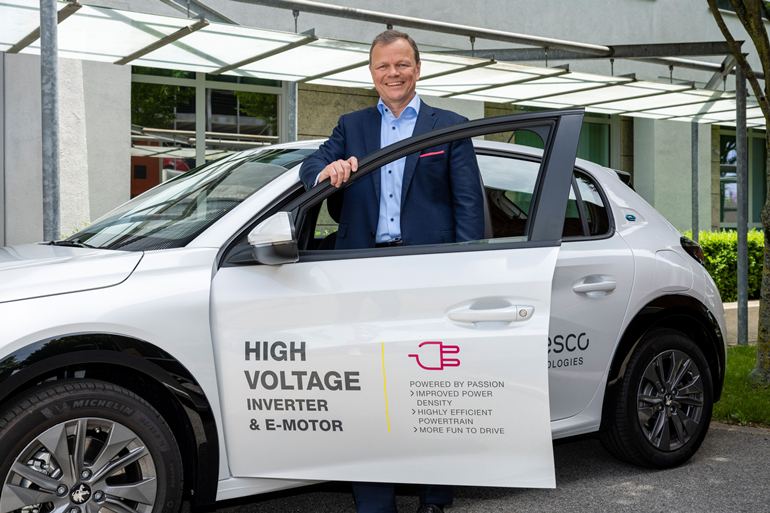 Germany's Vitesco Stays Agile in China Electrification to Break Even in 2024, Exec Says
Germany's Vitesco Stays Agile in China Electrification to Break Even in 2024, Exec Says(Yicai Global) July 28 -- Vitesco Technologies, a German drivetrain and powertrain supplier that used to be part of Continental, competes in the toughest electric vehicle market of the world by localizing, striving to break even globally next year, according to the electrification chief.
"It is a race," Thomas Stierle, who is also a member of the management board, said recently in an interview with Yicai Global. "The challenges in the China market for an international automotive supplier like us is how to adapt to the speed that is required and also the volatility."
To overcome these challenges, Vitesco leverages its experience, history, and technology to develop tailored solutions for the Chinese market. Stierle emphasized the importance of cost-effectiveness and finding the right platform at scale to differentiate and deliver value to customers.
Even when facing intense competition, Vitesco resists the idea of burning money to "buy" customers. With the prudent approach, the firm expects to break even next year. "We want to prove to ourselves and the outside that we can make money in e-mobility."
The Regensburg-based auto supplier makes all major components used in electric vehicles except for batteries, including master/zone controller, inverter, electric motor,battery management system, DC/DC converter, on-board charger and thermal management systems.
The company has invested over EUR500 million (USD548.9 million) in China since 2019. It has four mainland factories in locations, including Changchun, Tianjin, and Shanghai, as well as seven research and development centers with 6,500 employees to serve the Chinese market which is expected to produce around 35 percent of all electric cars in the world by 2030.
Below are excerpts from the interview:
YG: How does Vitesco’s localization strategy in China look like and how do you empower the local team?
Stierle: We have a strong R&D presence. Here we give a lot of autonomy and freedom to local teams to build on existing technology from global expertise and China market solutions.
I strongly believe in success by having proven technology available which is used in other areas of the world as base building blocks, and then using the local speed, and the local vision of what local customers need in order to try the best solutions for our customers.
For example, Vitesco supplies 800 voltage motor parts to XPeng Motors with eight layers of winding we don’t use anywhere else but in China. Vitesco provides Human Horizons with a unit that combines a battery management system with a master controller. What is also unique about this technology is that it was developed by the local team for the Chinese customer.
Besides, it is also important to have base production very local so that you are independent of geopolitical disruptions and supply chain issues. The technologies are pushing a lot into the complete supply chain in one market.
YG: What do you think are the challenges that Vitesco faces in electrification in China? How do you cope with these challenges?
Stierle: The challenges in the China market for an international automotive supplier like us is how to adapt to the speed which is required, and also the volatility. We are seeing models coming and going and models having higher volume than projected or low-volume platforms that are canceled and that is a dynamic which in the traditional automotive world is not seen. And for us, it's a challenge how to cope with this and how to deal but I also believe everyone -- even Chinese suppliers -- have the same challenge.
And that is why we are trying to find solutions basically based on our experience, history, and technology and doing Chinese solutions.
YG: How intense is the competition in China's auto market?
Stierle: First of all, I respect the competitors very much because they face the same challenges and some of them are also successful. So we are even looking at them to see what they might do better than us and what we can learn. I'm quite sure there are others looking at us. So it's a race.
It's all about the cost, especially for Vitesco. The differentiation factor for the consumer is about the user experience, autonomous driving, and fast charging. So then this is all about cost and that is why I strongly believe if you find the right platform in terms of scale that is where you can achieve. That is exactly our direction. For example, regarding the EMR3 high voltage axle drive system, one production line can produce 20 platforms for seven customers.
And I even believe that you can even generate value for the customer with that versus making it in-house. And I see this tendency and that is basically how we want to compete.
There is one important goal that I would like to share. At Vitesco Technologies, we will not buy businesses. In electrification, we want to prove to ourselves and the outside that we can make money in e-mobility. And with that, we expect to break even next year.
As for the earlier mentioned volatility and speed, we are fully able to manage the ups and downs of orders from customers thanks to the flexible design and flexible lines.
Editor: Emmi Laine